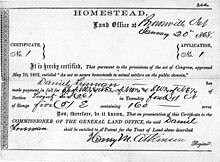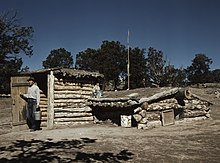Homestead Acts: Difference between revisions
No edit summary Tag: repeating characters |
|||
| Line 54: | Line 54: | ||
* [[Land patent]] |
* [[Land patent]] |
||
* [[Daniel Freeman]], the first person to file a claim under the Homestead Act. |
* [[Daniel Freeman]], the first person to file a claim under the Homestead Act. |
||
Whats up with screw on head and what that have to do with Homestead Act |
|||
==Further reading== |
==Further reading== |
||
Revision as of 19:46, 7 May 2010

The Homestead Act was one of several United States federal laws that gave an applicant freehold title to up to 160 acres (1/4 section, 65 hectares) of undeveloped federal land outside the original 13 colonies. The law required three steps: file an application, improve the land, and file for deed of title. Anyone who had never taken up arms against the U.S. government, including freed slaves, could file an application and evidence of improvements to a federal land office.
The original Homestead Act was signed into law by President Abraham Lincoln on May 20, 1862.[1][2][3][4][5][6] Because much of the prime low-lying alluvial land along rivers had been homesteaded by the turn of the twentieth century, a major update called the Enlarged Homestead Act was passed in 1909. It targeted land suitable for dryland farming, increasing the number of acres to 320.[7] In 1916, the Stock-Raising Homestead Act targeted settlers seeking 640 acres (260 ha) of public land for ranching purposes.[7]
Only about 40 percent of the applicants who started the process were able to complete it and obtain title to their homestead land.[8] Eventually 1.6 million homesteads were granted and 270,000,000 acres (420,000 sq mi) of federal land were privatized between 1862 and 1934, a total of 10% of all lands in the United States.[9] Homesteading was discontinued after 1976, except in Alaska. Individuals may no longer homestead on public land as a way to acquire title.
History
The Homestead Act was intended to liberalize the homesteading requirements of the Preemption Act of 1841. The "yeoman farmer" ideal was powerful in American political history, and plans for expanding their numbers through a homestead act were rooted in the 1850s. The South resisted, fearing the increase in free farmers would threaten plantation slavery.[10][11] Two men stood out as greatly responsible for the passage of the Homestead Act: George Henry Evans and Horace Greeley.[12][13] The agitation for free land became evident in 1844, when several bills were introduced unsuccessfully in Congress.[14] After the South seceded and their delegations left Congress in 1861, the path was clear of obstacles, and the act was passed.[3][4][15]
The Enlarged Homestead Act of 1909 gave 320 acres (1.3 km2) to farmers who accepted more marginal lands that could not be irrigated. A massive influx of new farmers eventually led to massive land erosion and the Dust Bowl of the 1930s.[16][17]
The end of homesteading

The Federal Land Policy and Management Act of 1976 ended homesteading;[4][18] the government believed that the best use of public lands was for them to remain in government control. The only exception to this new policy was in Alaska, for which the law allowed homesteading until 1986.[4]
The last claim under this Act was made by Ken Deardorff for 80 acres (32 hectares) of land on the Stony River in southwestern Alaska. He fulfilled all requirements of the Homestead Act in 1979, but did not receive his deed until May 1988. Therefore, he is the last person to receive title to land claimed under the provisions of the Homestead Act.[19]
Criticism
Dispossession of Indians
While distributing much land to farmers at minimal cost, homesteading took place on lands that had recently been cleared of Native Americans. Economically, the program was a large scale redistribution of land from autonomous tribes to taxpaying farmers, a process carried out directly when Indian reservations were broken up into holdings by individual families (especially in Oklahoma).
Fraud and corporate use
The Homestead Act was much abused.[4] Although its intent was to grant land for agriculture, in the arid areas east of the Rocky Mountains, 640 acres (2.6 km2) was generally too little land for a viable farm (at least prior to major public investments in irrigation projects). In these areas, homesteads were instead used to control resources, especially water. A common scheme was for an individual acting as a front for a large cattle operation to file for a homestead surrounding a water source under the pretense that the land was being used as a farm. Once granted, use of that water source would be denied to other cattle ranchers, effectively closing off the adjacent public land to competition.[citation needed] This method could also be used to gain ownership of timber and oil-producing land, as the federal government charged royalties for extraction of these resources from public lands. On the other hand, homesteading schemes were generally pointless for land containing "locatable minerals", such as gold and silver, which could be controlled through mining claims and for which the federal government did not charge royalties.
There was no systematic method used to evaluate claims under the Homestead Act. Land offices relied on affidavits from witnesses that the claimant had lived on the land for the required period of time and made the required improvements. In practice, some of these witnesses were bribed or otherwise collaborated with the claimant.[citation needed] In any case, the land was turned into farms.
Although not necessarily fraud, it was common practice for the eligible children of a large family to claim nearby land as soon as possible. After a few generations, a family could build up a sizable estates.[citation needed] [20] Working a farm of 1,500 acres (6.1 km2) would not have been feasible for a homesteader using 19th-century animal-powered tilling and harvesting. The acreage limits were reasonable when the act was written.
Related acts in other countries
The act was later imitated with some modifications by Canada in the form of the Dominion Lands Act. Similar acts—usually termed the Selection Acts—were passed in the various Australian colonies in the 1860s, beginning in 1861 in New South Wales.
Popular culture
- In the writings of Laura Ingalls Wilder (Little House on the Prairie series), she describes her father claiming a homestead in Kansas, and later Dakota Territory.
- Willa Cather's book, O Pioneers!, is a narrative following the life of a homesteading family living in Nebraska before the turn of the century.
- The Oklahoma land rush is a major scene in the Rodgers and Hammerstein musical Oklahoma.
- The Homestead Act is used as the ruse to allow The Amazing Screw-On Head[dubious – discuss] to investigate paranormal[dubious – discuss] activities west of the Mississippi River without arousing Confederate suspicion.
See also
- Land Act of 1804
- Military Tract of 1812
- Preemption Act of 1841
- Donation Land Claim Act of 1850
- Public Land Survey System
- Land grants
- Land patent
- Daniel Freeman, the first person to file a claim under the Homestead Act.
Whats up with screw on head and what that have to do with Homestead Act
Further reading
- Dick, Everett, 1970. The Lure of the Land: A Social History of the Public Lands from the Articles of Confederation to the New Deal.
- Gates, Paul W., 1996. The Jeffersonian Dream: Studies in the History of American Land Policy and Development.
- Hyman, Harold M., 1986. American Singularity: The 1787 Northwest Ordinance, the 1862 Homestead and Morrill Acts, and the 1944 G.I. Bill.
- Lause, Mark A., 2005. Young America: Land, Labor, and the Republican Community.
- Phillips, Sarah T., 2000, "Antebellum Agricultural Reform, Republican Ideology, and Sectional Tension." Agricultural History 74(4): 799-822. ISSN 0002-1482
- Richardson, Heather Cox, 1997. The Greatest Nation of the Earth: Republican Economic Policies during the Civil War.
- Robbins, Roy M., 1942. Our Landed Heritage: The Public Domain, 1776-1936.
- Smith, Henry Nash. Virgin Land: The American West as Symbol and Myth. New York: Vintage, 1959.
References and notes
Specific references:
- ^ "Our Documents - Homestead Act (1862)".
- ^ "Homestead Act: Primary Documents in American History". Library of Congress. 2007-09-21. Retrieved 2007-11-22.
- ^ a b McPherson. - pp.450-451. Cite error: The named reference "mcpherson" was defined multiple times with different content (see the help page).
- ^ a b c d e "The Florida Homestead Act of 1862". Florida Homestead Services. 2006. Retrieved 2007-11-22. (paragraphs.3,6&13) (Includes data on the U.S. Homestead Act)
- ^ "V. Webster Johnson" (1979). "Land Problems and Policies". Arno Press. p. 46. Retrieved 2009-05-26.
- ^ "Homestead National Monument: Frequently Asked Questions". National Park Service. Retrieved 2009-05-26.
- ^ a b Split EstatePrivate Surface / Public Minerals: What Does it Mean to You?, a 2006 Bureau of Land Management presentation
- ^ United States, Department of the Interior, National Park Service. “Homesteading by the Numbers”, accessed 5 February 2010.
- ^ The Homestead Act of 1862. - Archives.gov
- ^ Phillips. - p.2000.
- ^ McPherson. - p.193.
- ^ McElroy. - p.1.
- ^ "Horace Greeley". - Tulane University. - August 13, 1999. - Retrieved: 2007-11-22.
- ^ McPherson. - p.194.
- ^ McElroy. - p.2.
- ^ List of Laws about Lands. - The Public Lands Museum
- ^ Hansen, Zeynep K., and Gary D. Libecap. - "U.S. Land Policy, Property Rights, and the Dust Bowl of the 1930s". Social Science Electronic Publishing. - September, 2001.
- ^ Cobb, Norma (2000). Arctic Homestead: The True Story of a Family's Survival and Courage... St. Martin's Press. p. 21. ISBN 0312283792. Retrieved 2007-11-22.
- ^ "The Last Homesteader". National Park Service. 2006. Retrieved 2007-11-22.
- ^ Hansen, Zeynep K., and Gary D. Libecap. "Small Farms, Externalities, and the Dust Bowl of the 1930s". - Journal of Political Economy. - Volume: 112(3). - pp.665-94. - November 21, 2003
General references:
- McElroy, Wendy (2001). "The Free-Soil Movement, Part 1". The Future of Freedom Foundation. Retrieved 2007-11-22.
- McPherson, James M. (1998). Battle Cry of Freedom: The Civil War Era. Oxford University Press. pp. 193–195. ISBN 019516895X.
External links
- Homestead Act. - Library of Congress
- Homestead National Monument of America. - National Park Service
- "About the Homestead Act". - National Park Service
- Homestead Act of 1862. - National Archives and Records Administration
- Homesteaders and Pioneers on the Olympic Peninsula. - Olympic Peninsula Community Museum. - University of Washington. - Online museum exhibit that documents the history of several families who moved to the Olympic Peninsula following the Homestead Act of 1862
- "Adeline Hornbek and the Homestead Act: A Colorado Success Story". - National Park Service Teaching with Historic Places (TwHP) lesson plan. - National Park Service
